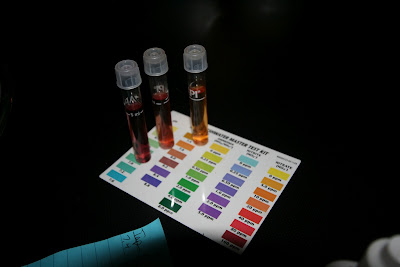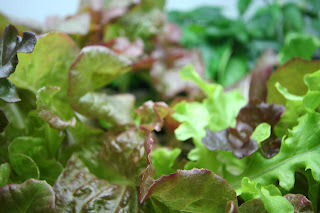pH
pH is a measure of the activity of the (solvated) hydrogen ion*. To the average aquapon that is very confusing. pH is the way we measure how acidic or alkaline a liquid is. Pure water will have a pH of 7. The pH scale goes from 1-14, 1 being very very acidic and 14 being very very alkaline. Substances with these extreme pH's are extremely dangerous and some can eat through human flesh! Another "cool" property of the pH is its logarithmic. The numbers actually increase and decrees exponentially. 8 is 10x more alkaline that 7, and 9 is 100x more alkaline! The same is true for the acidic side of the scale. So you can see that pH can change FAST and can run wild if left uncorrected.
To figure out what the pH of your aquaponics system should be, you need to take into consideration the organisms living in your system. Plants generally like a pH of 5.0-7.0; Fish like 6.5-8.0; The bacteria and worms (if you do not have worms, I recommend them) like the pH to be 6.0-8.0. This leaves us with some comprising, 6.8-7.0 is supposedly the industry standard. But remember, these are optimal conditions. A system can fluctuate around these numbers and still have a perfectly functioning system. My system at home has a slightly higher pH of 7.5-7.8. My African Cichlids like the water to be a bit harder and to have a tad higher pH. Since I used my existing aquarium for my aquaponics, I did not try and change my pH.
One reason pH has to be watched in aquaponics is a phenomena called nutrient lockout. When a plant is out of its optimal pH range, it will have trouble up-taking nutrients. This is problematic as you can imagine. If plants are not eating, they will be negatively affected (duh!). Murray Halllam, one of the great aquaponic grandfathers, comments on nutrient lockout and provides a chart in this forum.
My buddy Alex Blackwell has ben having trouble the pH in his system. The Blackwell System has a pH of 8.5! That's quite high! So we are trying to figure it out together. We set up a test to determine what is causing his pH to raise so much. The suspected culprit is the grow stones used in the Blackwell System.
We wanted to be diligent with our test. Three bowls were gathered. In the first bowl was the top off water. It has a ph of 7.4 or so after siting over night to "gas off." The second bowl we placed clean grow media and the top off water. Just after adding them, the pH was the same as the top off water, 7.4. The third bowl we placed grow stones from the system that had a bit of algae growing on them, we figured the algae might also play a roll in raising the pH. After adding the water, the ph was also 7.4.
An hour after the initial start, we tested them again and the pH changed very little, not enough to even write about! So we decided to wait till morning to test again.
Here we saw some BIG results. When we tested the next day the pHs have changed quite dramatically. The top off water had stayed the same (as we expected). The second bowl with the new grow stones has shot up to 8.4! The third bowl with the algae grow stones raised up to 8.6! So we are very sure that the stones play a roll in raising the pH.
 |
| The final pH testing. |
The next step, is how to address this problem. The grow stones used are made of 100% recycled glass. When purchased no thought was given to how it would effect the pH. After all, the equipment one uses to measure pH is made of glass!
Serious thinking has been put into this problem. These are the options that we came up with.
A. Switch out the grow stones
B. Add pH balancer
C. Flush out the grow stones
D. Do nothing and let the system "work itself out"
Replacing the grow stones and buying new media is very expensive and with so many established plants and bacteria, replacing it would set the system back. This will be the last resort.
Alex tried option B, and went through a whole bottle of "pH Down," a popular hydroponic pH corrector. This however had little effect. This means that there is something continually raising the pH. Another option will have to be used.
Our local aquaponic / hydroponic shop, Route 66 Aquaponics, store owner Shaun helped us brainstorm. He suggested flushing the grow beds into a separate container to "rinse" the grow bed and add fresh, pH corrected water to replace taken out. We did a 35%- 45% water change and refilled it with pH neutral water. This helped the system a lot and cleared up the water but the pH is still high.
Our conclusion is to let the system try and "work itself out." The system is still quite young at only a few months old. Once it is fully established, which can take up to a year I have read, the system will be more stable. Plus the plants and fish look happy. The plants are flowering, the fish are mating, the systems inhabitants seem to not be affected by the high pH.
Alex did say he had some tomato plants that were doing great during their vegetative stage, but as soon as they started flowering, they died off. This may have been due to the high pH.
Root 66 Aquaponics owner, Shawn explained to us that the tomatoes may not have had enough nutrients to flower since the system was even younger than. This makes sense. Plants need much more nutrients while flowering and at that time the system most likely did not have the beneficial bacteria build up to support a few flowering tomatoes plants.
 |
Our Aquaponic dinner salad.
It has much more taste than salad bought in stores. |
But as you can see the Blackwell System is Rockin' even with a high pH. We enjoyed a lovely salad and pasta tonight. We used salad and basil from the home system. Delicious.
 |
Alex Blackwell harvesting his aquaponic garden. The salad was harvested just a few days ago too.
The plants, as you can see, are thriving despite the high pH. |
*taken from Wikipedia






















